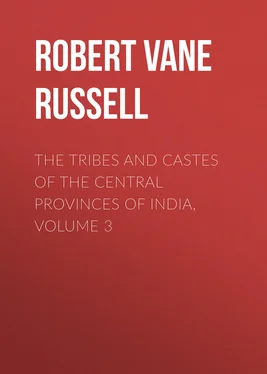Robert Vane Russell - The Tribes and Castes of the Central Provinces of India, Volume 3
Здесь есть возможность читать онлайн «Robert Vane Russell - The Tribes and Castes of the Central Provinces of India, Volume 3» — ознакомительный отрывок электронной книги совершенно бесплатно, а после прочтения отрывка купить полную версию. В некоторых случаях можно слушать аудио, скачать через торрент в формате fb2 и присутствует краткое содержание. Жанр: foreign_prose, История, foreign_edu, foreign_antique, на английском языке. Описание произведения, (предисловие) а так же отзывы посетителей доступны на портале библиотеки ЛибКат.
- Название:The Tribes and Castes of the Central Provinces of India, Volume 3
- Автор:
- Жанр:
- Год:неизвестен
- ISBN:нет данных
- Рейтинг книги:5 / 5. Голосов: 1
-
Избранное:Добавить в избранное
- Отзывы:
-
Ваша оценка:
- 100
- 1
- 2
- 3
- 4
- 5
The Tribes and Castes of the Central Provinces of India, Volume 3: краткое содержание, описание и аннотация
Предлагаем к чтению аннотацию, описание, краткое содержание или предисловие (зависит от того, что написал сам автор книги «The Tribes and Castes of the Central Provinces of India, Volume 3»). Если вы не нашли необходимую информацию о книге — напишите в комментариях, мы постараемся отыскать её.
The Tribes and Castes of the Central Provinces of India, Volume 3 — читать онлайн ознакомительный отрывок
Ниже представлен текст книги, разбитый по страницам. Система сохранения места последней прочитанной страницы, позволяет с удобством читать онлайн бесплатно книгу «The Tribes and Castes of the Central Provinces of India, Volume 3», без необходимости каждый раз заново искать на чём Вы остановились. Поставьте закладку, и сможете в любой момент перейти на страницу, на которой закончили чтение.
Интервал:
Закладка:
50. Witchcraft
The belief in witchcraft has been till recently in full force and vigour among the Gonds, and is only now showing symptoms of decline. In 1871 Sir C. Grant wrote: 75 75 C. P. Gazetteer (1871), Introduction, p. 130.
“The wild hill country from Mandla to the eastern coast is believed to be so infested by witches that at one time no prudent father would let his daughter marry into a family which did not include among its members at least one of the dangerous sisterhood. The non-Aryan belief in the power of evil here strikes a ready chord in the minds of their conquerors, attuned to dread by the inhospitable appearance of the country and the terrible effect of its malicious influences upon human life. In the wilds of Mandla there are many deep hillside caves which not even the most intrepid Baiga hunter would approach for fear of attracting upon himself the wrath of their demoniac inhabitants; and where these hillmen, who are regarded both by themselves and by others as ministers between men and spirits, are afraid, the sleek cultivator of the plains must feel absolute repulsion. Then the suddenness of the epidemics to which, whether from deficient water-supply or other causes, Central India seems so subject, is another fruitful source of terror among an ignorant people. When cholera breaks out in a wild part of the country it creates a perfect stampede—villages, roads, and all works in progress are deserted; even the sick are abandoned by their nearest relations to die, and crowds fly to the jungles, there to starve on fruits and berries till the panic has passed off. The only consideration for which their minds have room at such times is the punishment of the offenders, for the ravages caused by the disease are unhesitatingly set down to human malice. The police records of the Central Provinces unfortunately contain too many sad instances of life thus sacrificed to a mad unreasoning terror.” The detection of a witch by the agency of the corpse, when the death is believed to have been caused by witchcraft, has been described in the section on funeral rites. In other cases a lamp was lighted and the names of the suspected persons repeated; the flicker of the lamp at any name was held to indicate the witch. Two leaves were thrown on the outstretched hand of a suspected person, and if the leaf representing her or him fell above the other suspicion was deepened. In Bastar the leaf ordeal was followed by sewing the person accused into a sack and letting her down into shallow water; if she managed in her struggles for life to raise her head above water she was finally adjudged to be guilty. A witch was beaten with rods of the tamarind or castor-oil plants, which were supposed to be of peculiar efficacy in such cases; her head was shaved cross-wise from one ear to the other over the head and down to the neck; her teeth were sometimes knocked out, perhaps to prevent her from doing mischief if she should assume the form of a tiger or other wild animal; she was usually obliged to leave the village, and often murdered. Murder for witchcraft is now comparatively rare as it is too often followed by detection and proper punishment. But the belief in the causation of epidemic disease by personal agency is only slowly declining. Such measures as the disinfection of wells by permanganate of potash during a visitation of cholera, or inoculation against plague, are sometimes considered as attempts on the part of the Government to reduce the population. When the first epidemic of plague broke out in Mandla in 1911 it caused a panic among the Gonds, who threatened to attack with their axes any Government officer who should come to their village, in the belief that all of them must be plague-inoculators. In the course of six months, however, the feeling of panic died down under a system of instruction by schoolmasters and other local officials and by circulars; and by the end of the period the Gonds began to offer themselves voluntarily for inoculation, and would probably have come to do so in fairly large numbers if the epidemic had not subsided.
51. Human sacrifice. 76 76 This section contains some information furnished by R. B. Hīra Lāl.
The Gonds were formerly accustomed to offer human sacrifices, especially to the goddess Kāli and to the goddess Danteshwari, the tutelary deity of the Rājas of Bastar. Her shrine was at a place called Dantewāra, and she was probably at first a local goddess and afterwards identified with the Hindu goddess Kāli. An inscription recently found in Bastar records the grant of a village to a Medipota in order to secure the welfare of the people and their cattle. This man was the head of a community whose business it was, in return for the grants of land which they enjoyed, to supply victims for human sacrifice either from their own families or elsewhere. Tradition states that on one occasion as many as 101 persons were sacrificed to avert some great calamity which had befallen the country. And sacrifices also took place when the Rāja visited the temple. During the period of the Bhonsla rule early in the nineteenth century the Rāja of Bastar was said to have immolated twenty-five men before he set out to visit the Rāja of Nāgpur at his capital. This would no doubt be as an offering for his safety, and the lives of the victims were given as a substitute for his own. A guard was afterwards placed on the temple by the Marāthas, but reports show that human sacrifice was not finally stamped out until the Nāgpur territories lapsed to the British in 1853. At Chānda and Lānji also, Mr. Hislop states, human sacrifices were offered until well into the nineteenth century 77 77 Notes on the Gonds , pp. 15, 16.
at the temples of Kāli. The victim was taken to the temple after sunset and shut up within its dismal walls. In the morning, when the door was opened, he was found dead, much to the glory of the great goddess, who had shown her power by coming during the night and sucking his blood. No doubt there must have been some of her servants hid in the fane whose business it was to prepare the horrid banquet. It is said that an iron plate was afterwards put over the face of the goddess to prevent her from eating up the persons going before her. In Chānda the legend tells that the families of the town had each in turn to supply a victim to the goddess. One day a mother was weeping bitterly because her only son was to be taken as the victim, when an Ahīr passed by, and on learning the cause of her sorrow offered to go instead. He took with him the rope of hair with which the Ahīrs tie the legs of their cows when milking them and made a noose out of it. When the goddess came up to him he threw the noose over her neck and drew it tight like a Thug. The goddess begged him to let her go, and he agreed to do so on condition that she asked for no more human victims. No doubt, if the legend has any foundation, the Ahīr found a human neck within his noose. It has been suggested in the article on Thug that the goddess Kāli is really the deified tiger, and if this were so her craving for human sacrifices is readily understood. All the three places mentioned, Dantewāra, Lānji and Chānda, are in a territory where tigers are still numerous, and certain points in the above legends favour the idea of this animal origin of the goddess. Such are the shutting of the victim in the temple at night as an animal is tied up for a tiger-kill, and the closing of her mouth with an iron plate as the mouths of tigers are sometimes supposed to be closed by magic. Similarly it may perhaps be believed that the Rāja of Bastar offered human sacrifices to protect himself and his party from the attacks of tigers, which would be the principal danger on a journey to Nāgpur. In Mandla there is a tradition that a Brāhman boy was formerly sacrificed at intervals to the god Bura Deo, and the forehead of the god was marked with his hair in place of sandalwood, and the god bathed in his blood and used his bones as sticks for playing at ball. Similarly in Bindrānawāgarh in Raipur the Gonds are said to have entrapped strangers and offered them to their gods, and if possible a Brāhman was obtained as the most suitable offering. These legends indicate the traditional hostility of the Gonds to the Hindus, and especially to the Brāhmans, by whom they were at one time much oppressed and ousted from their lands. According to tradition, a Gond Rāja of Garha-Mandla, Madhkur Shāh, had treacherously put his elder brother to death. Divine vengeance overtook him and he became afflicted with chronic pains in the head. No treatment was of avail, and he was finally advised that the only means of appeasing a justly incensed deity was to offer his own life. He determined to be burnt inside the trunk of the sacred pīpal tree, and a hollow trunk sufficiently dry for the purpose having been found at Deogarh, twelve miles from Mandla, he shut himself up in it and was burnt to death. The story is interesting as showing how the neurotic or other pains, which are the result of remorse for a crime, are ascribed to the vengeance of a divine providence.
Интервал:
Закладка:
Похожие книги на «The Tribes and Castes of the Central Provinces of India, Volume 3»
Представляем Вашему вниманию похожие книги на «The Tribes and Castes of the Central Provinces of India, Volume 3» списком для выбора. Мы отобрали схожую по названию и смыслу литературу в надежде предоставить читателям больше вариантов отыскать новые, интересные, ещё непрочитанные произведения.
Обсуждение, отзывы о книге «The Tribes and Castes of the Central Provinces of India, Volume 3» и просто собственные мнения читателей. Оставьте ваши комментарии, напишите, что Вы думаете о произведении, его смысле или главных героях. Укажите что конкретно понравилось, а что нет, и почему Вы так считаете.












